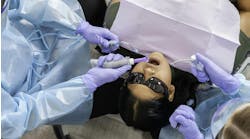The Aspen Group now has more than 1,000 offices. Heartland Dental boasts more than 1,600 locations, while Pacific Dental has over 900 offices. This all amounts to tens of thousands of employees and millions of patients, and dental service organizations (DSOs) are growing by hundreds of offices each year. DSOs are behemoths with tremendous purchasing power and a marketing reach across America, and they can be intimidating when they use their scale to wring cost out of the system.
It’s expensive to build a dental practice
- Student debt is growing rapidly: In 1996, the average dental school debt was $103,350. In 2019, it was $291,440, an increase of 182%!1
- Technology investments are relentlessly expanding: According to MedCity News, “While we can’t control the future, we can be sure of one thing—10 years down the road, we can expect remarkable changes in the dental industry that will completely revolutionize dental health-care facilities worldwide.” Some of the technologies include 3D printing, digital dentistry, tooth remineralization, augmented reality, and teledentistry.2
- Prices are remaining flat: Inflation-adjusted prices for dental services have generally been flat for the last two decades. While debt and investment costs are growing, the ability to pass these costs onto patients is not happening easily.3
You might also want to read: How I compete with that DSO-supported office down the street
Despite this difficult environment, boutique, family, group, and solo dental practices have the tools they need to compete with DSOs. The small players can build deep personal and community relationships, offer unique services, create engaging experiences, and often provide better care. While they may not match the efficiency of DSOs, they can differentiate themselves by offering something distinct.
Once upon a time, the cranky dentist with the poorly run office could thrive, but no longer. Today’s patients will not tolerate having to wait. They will not accept feeling rushed or inconvenienced. Finding another provider after a mediocre experience is a simple Google search away. Worse, that mediocre experience may generate a negative online review that can undermine a practice’s fragile patient flow.
Building a successful practice requires a smooth-running operation, not the cost-cutting and marketing machines of the DSOs. It calls for a well-run business that removes inefficiency, enables a strong client experience, and creates an engaged office environment. The practice must maintain a rewarding environment where employees thrive, do not leave, and work with a heartfelt passion.
The importance of business operating systems
Business operating systems (BOS) are not typically taught in dental schools, but in business schools. A BOS is a framework that defines how the business operates and includes an organizational chart, vision for the future, core processes, strategic goals, and performance metrics. The critical by-product is a better experience for patients.
The two most established BOSs for small businesses—the Entrepreneurial Operating System (EOS) and Scaling Up—have been around for more than 15 years and are working with hundreds of thousands of companies. Both systems leverage coaches to teach the systems to small and midsized businesses, and they offer books for those who want to do it on their own. The book for EOS is called Traction, and the book for Scaling Up is called Scaling Up.
Dr. Apeksha Pole of B Dental Spa in Bogota, New Jersey, discussed her experience with EOS. “Prior to using EOS, our meetings were disorganized. We went from topic to topic without a clear vision in mind, without a clear idea of how we were going to solve all the different things. We wouldn’t really come to a resolution. We needed steps along the way and guidance about what we needed to do in order to get here.”
B Dental recently opened their third location in Norwood, New Jersey. Dr. Pole continued, “We broke every big goal down into small goals. That was really rewarding because every time we met, we’d say, ‘Wow, we did this. We’re closer, we’re closer!’ When the third location started to become reality, it happened more quickly and easily than we thought it would.”4
A BOS forces a practice to create a leadership team, define its vision, identify the most important metrics, and create a regular meeting cadence to drive alignment and focus. By creating a tighter alignment to the plan, communication becomes easier and performance jumps. An additional key by-product is a deep accountability running from top to bottom across the organization, leading to better client engagement.
Efficiency, in turn, leads to an environment that will adjust to market changes, find the best path to navigate forward, and enable continued success in an increasingly competitive market. Any time a market is disrupted, there are winners and losers. The companies with a strong BOS will certainly be on the winning side.
While DSOs may be disrupting the established dental market, the small players have everything they need to thrive with the change.
Editor's note: This article appeared in the July 2023 print edition of Dental Economics magazine. Dentists in North America are eligible for a complimentary print subscription. Sign up here.
References
- Hanson M. Average dental school debt. EducationData.org. November 19, 2022. Accessed April 17, 2023. https://educationdata.org/average-dental-school-debt
- Swaida F. Trends in the dental industry: Dental technology in the next decade. MedCityNews. April 7, 2021.https://medcitynews.com/2021/04/trends-in-the-dental-industry-dental-technology-in-the-next-decade/
- Gupta N, Vujicic M, Blatz A. Trends in fees and reimbursement rates for the most common procedures in endodontics, periodontics, prosthodontics, and oral surgery. ADA HPI. Revised April 2017. https://www.ada.org/-/media/project/ada-organization/ada/ada-org/files/resources/research/hpi/hpibrief_0217_2.pdf
- B Dental Spa and EOS. Accessed April 17, 2023. https://www.youtube.com/watch?v=mGvTgXaF95o.






